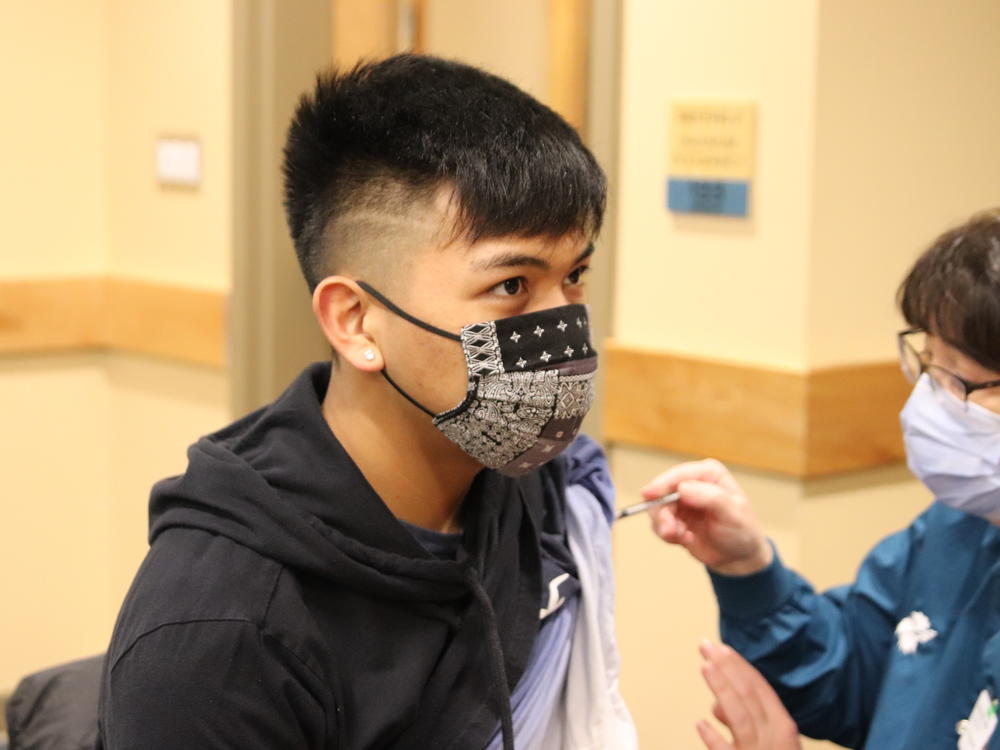Section Branding
Header Content
Alaska Town Now Vaccinating Everyone 16 And Older
Primary Content
The COVID-19 vaccine clinic set up at Sitka, Alaska's civic center looks different from many in the lower 48. No lines. No crowds. Patients pop in every few minutes for their appointments, and they don't have to wait very long before a nurse directs them to roll up their sleeve.
Another big difference? Some of the faces are younger. Much younger.
The COVID-19 vaccine rollout has been bumpy in much of the country, but it's going surprisingly well in the remote island town of Sitka. The region's Tribal health organization has been so efficient, it's already vaccinated those at high risk and is now offering vaccines to everyone 16 and older.
"I feel very lucky and thankful that I got the shot," says 17-year-old Bradley Westlock. He's a senior at Mt. Edgecumbe High School in town. He and a group of his classmates got their second doses of the Pfizer vaccine.
"Hoping that everything will go back to normal once everyone gets vaccinated," says Westlock. "Normal" for him is attending school in Sitka and being able to travel home over breaks. He's from the Yup'ik village of Emmonak, on the mouth of the Yukon River in Western Alaska. He's hoping now that he's vaccinated, traveling home to see his grandparents will be safer.
"That's why I got it," he says. "Just to protect them."
Westlock and his peers are some of the first teens in the country to receive the vaccine. And that's no accident.
"Young people are people that move through the community quickly. They have lots of social activities and lots of social contact," says Dr. Elliot Bruhl, the chief medical officer at the Southeast Alaska Regional Health Consortium. Sitka has a population of around 8500 people, and health workers able to vaccinate around 750 people each week.
"As these vaccines came, we saw it as a moral and ethical imperative that we did not leave vaccines sitting in the freezer," says Bruhl.
Bruhl says there are a few reasons the hospital's vaccine rollout has been so successful. They've received enough supply of the vaccine from both the state and the Indian Health Service (IHS), and the IHS has been extremely efficient across the whole country in getting vaccines out. Bruhl says the public health goal is vaccinating whole communities, Alaska Native people and non-Native residents alike.
"Elbow grease" is another reason, according to Bruhl. "You know, attitude makes the difference in life and in work, and in this instance, we said this is our number one priority, and we put the muscle behind that." he says
By mid-February, Bruhl's clinic opened up vaccinations to everyone 16 and older.
Like high school student Silas Demmert. He jumped at the opportunity. He's a cross country runner, and in the summer he works at a local grocery store. He got his first shot on Tuesday.
"I want it and it's nice to have that sense of immunity," he says. "But I'm also 16, I'm kind of healthier, so it was nice to hear that they're getting it to people that need it more quicker."
"Honestly it's thrilling," chimes in Silas's mom, Emily Demmert. She's an English teacher at Sitka High School. She got vaccinated in early February, but when her students started flexing their vaccine cards, she really breathed a sigh of relief.
"When a couple of my students shared that they were getting the vaccine the other day, I just got this spark of joy that was like, 'Yes!'" she says.
Demmert hopes the vaccines will help both her school and her home become less distant and more social.
"Now we're really going to see some changes," she says.
Copyright 2021 KCAW. To see more, visit KCAW.

